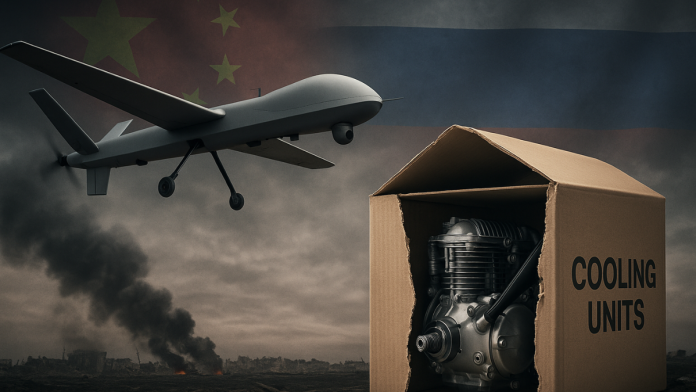A major loophole in global sanctions has been exposed. Chinese engines meant for military use are being quietly shipped to Russia, but under fake labels. These engines are reportedly helping power deadly drones used in the war against Ukraine. Investigators say this covert trade could be a deliberate attempt to bypass international restrictions.
Secret Shipments Uncovered
Chinese-made engines are being sent to Russia, but not under their real name. Instead, they are labeled as “industrial cooling units.” These secret shipments are meant to avoid Western sanctions that were placed on both countries due to their military actions.
According to documents reviewed by a media house and information from European security officials, the engines are being delivered to IEMZ Kupol, a Russian state-owned company that builds military technology. These engines are not used for factories or basic machinery—they are installed in Garpiya-A1 attack drones. These drones are actively used in strikes on both military and civilian targets in Ukraine.
This method of hiding military equipment under misleading product labels is sparking global concern. Sanctions were set up to block countries and companies from helping Russia’s war efforts, but this case shows how some businesses may be skirting the rules.
🚨 China’s silent takeover: battery plants and billion-euro deals replace football clubs in Europe
Drones Used in Attacks Across Ukraine
The Garpiya-A1 is a long-range, unmanned attack drone. It can travel great distances and hit its targets without a human pilot. It has been widely used in the war in Ukraine, causing destruction and loss of life. The Chinese engines allow these drones to fly farther and more efficiently.
An internal Russian document shows that IEMZ Kupol signed a major deal with the Russian Ministry of Defense. The agreement is to produce over 6,000 of these drones by the end of 2025. As of April 2025, more than 1,500 units had already been delivered to the Russian military.
Ukraine’s military intelligence confirmed the heavy usage of these drones, estimating that around 500 Garpiya-A1 units are deployed each month. This shows how quickly production is moving—and how crucial the engine supply has become.
Before October 2024, Kupol used engines from Xiamen Limbach Aviation Engine Co., a Chinese company that has since been sanctioned by both the European Union and the United States. After those sanctions, a new supplier, Beijing Xichao International Technology and Trade, began providing engines. However, these shipments were marked as cooling equipment to avoid detection.
China’s Response and Rising Tensions
Following the discovery, China’s Foreign Ministry stated it was unaware of the shipments. A spokesperson said that China respects international rules and controls all exports that could have both civilian and military uses. Still, questions are being raised about how such shipments were allowed to proceed.
The European Commission, under the leadership of President Ursula von der Leyen, is taking the issue seriously. Von der Leyen is traveling to Beijing to meet with President Xi Jinping and Premier Li Qiang. The talks are expected to include strong concerns over China’s role in supplying technology that ends up in Russian weapons.
This issue highlights the difficulty in fully enforcing international sanctions. Even with global restrictions in place, some companies are still finding ways to move key components across borders. The engines labeled as “cooling units” offer a clear example of how these efforts can go unnoticed.
As the war continues, such hidden support could have a big impact on the battlefield. The use of mislabeled military parts raises serious concerns about international trade, security, and accountability.


